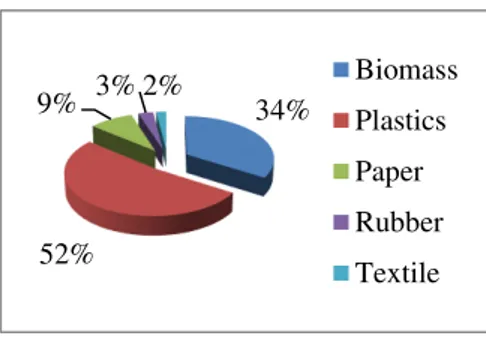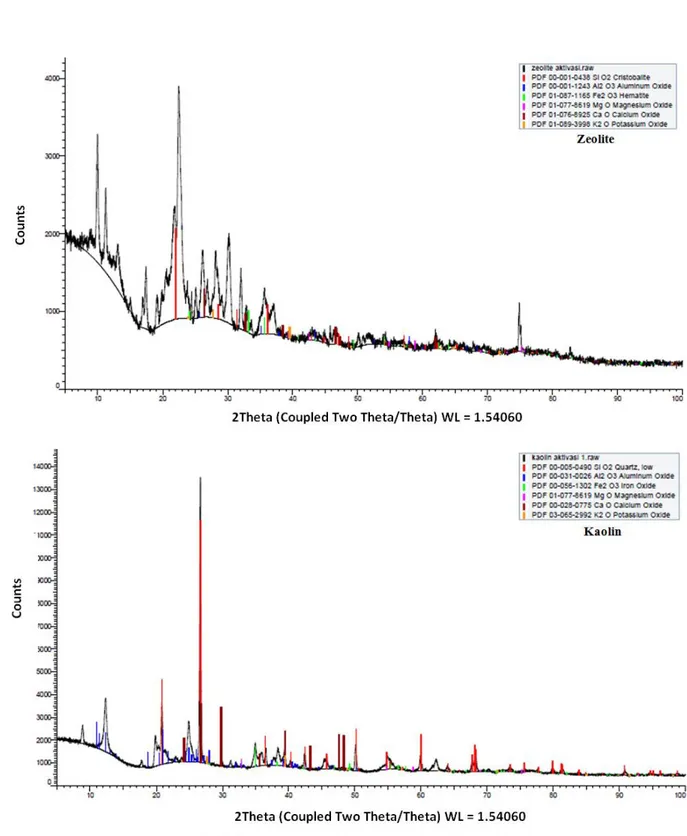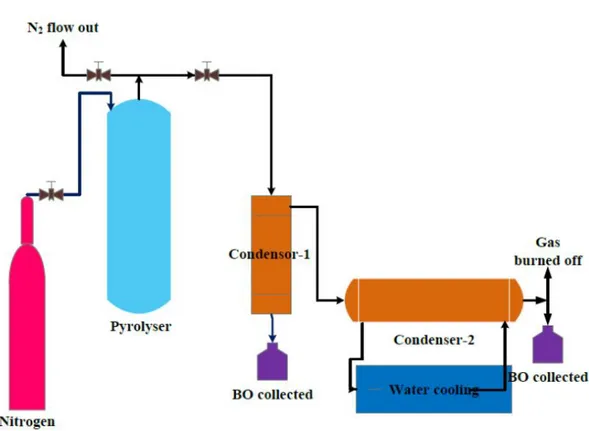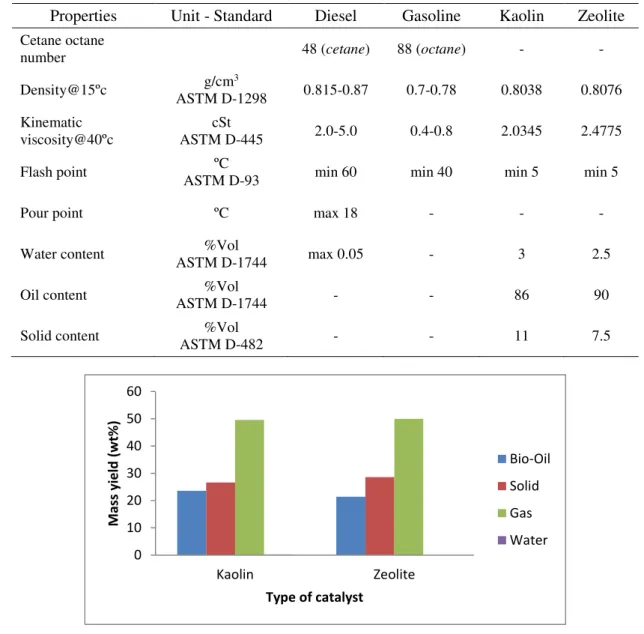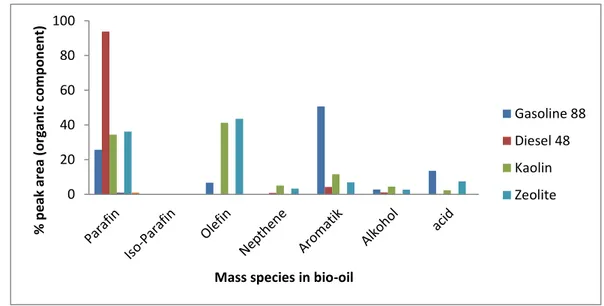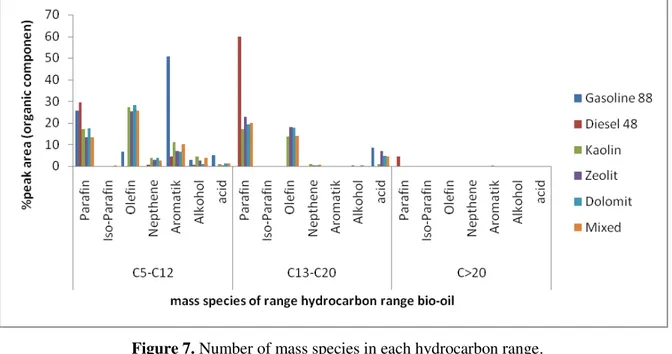Effect of natural zeolite and kaolin as a catalyst in the
1isothermal-catalytic cracking of real municipal solid waste
2(MSW) for bio-oil production
3I M Gandidi1*, M D Susila1 and H Rustamaji2 4
1 Department of Mechanical Engineering, Faculty of Engineering, University of 5
Lampung, Jl. S. Brojonegoro, Bandarlampung 35145, Indonesia 6
2 Department of Chemical Engineering, Faculty of Engineering, University of 7
Lampung, Jl. S. Brojonegoro, Bandarlampung 35145, Indonesia 8
*Email: [email protected] 9
Abstract. A real MSW conversion into bio-oil by pyrolysis method had been investigated. The 10
pyrolysis experiment was carried out in an isothermal fixed bed reactor at 400 °C for 60 min. 11
Natural activated zeolite and kaolin catalysts were employed in this process with catalyst-MSW 12
at ratio of 0.5 w/w. Influence of activated catalyst to pyrolysis productivity and bio-oil properties 13
were studied. Comparison between zeolite and kaolin catalytic pyrolysis was examined and bio-14
oil products were analyzed by GC-MS. The yields of liquid fuel or bio-oil were found around 15
23.6 and 21.4% for kaolin and zeolite catalytic pyrolysis, respectively. The carbon range 16
distribution in bio-oil were 65.38% of gasoline range (C5-C12) and 33.49% of diesel range (C13 -17
C20) for activated kaolin catalytic cracking. Activated zeolite had 51.62% of gasoline range (C5 -18
C12) and 48.37% of diesel range (C13-C20). The results showed that both of bio-oil products 19
mostly contained paraffin and olefin. The use of kaolin as catalyst was better than zeolite in 20
converting the real MSW into bio-oil. 21
1. Introduction 22
The open dumping system of municipal solid waste (MSW) in Indonesia has created a lot of impacts for 23
people and environment in which the system is no longer relevant due to the limitations in the urban 24
area [1]. The landfill becomes a habitat for insects, pests and bacteria that can spread various diseases 25
in the open environment. The piles of garbage in the landfill will produce some leachate that 26
contaminates the ground and surface water [2]. Furthermore, MSW will be degraded biochemically and 27
produce methane gas into the atmosphere. It is known that the potential of methane gas pollution is 28
about twenty times more dangerous than the pollution by CO2 [3]. In addition, MSW is one of major 29
contributors for flood and increased risk of global warming and greenhouse gas effect [4]. 30
On the other hand, MSW is a material contains energy in the form of chemical bonds between 31
molecules of carbon, hydrogen and oxygen. When the chemical bonds are destroyed, the organic 32
material will release the chemical energy in the form of gas, liquid and solid which is commonly called 33
biofuel [5,6]. The calorific value content is around 20.57 MJ/kg [7]. Thus, MSW is one of the potential 34
energy materials that can be converted into bio-energy. Pyrolysis is one method proposed for bio-energy 35
production from MSW. Pyrolysis is a thermal degradation in which MSW is converted into solid 36
temperature in the absence of oxygen [8]. Usually the temperature used is in the range of 400-600 °C. 38
This process is intended to break down the long hydrocarbon chains into short-chain hydrocarbons. 39
Hence, MSW appears to be eligible to be developed as a raw material for bio-oil production by pyrolysis 40
technique [9-12]. MSW converted into bio-oil has attracted much attention due to its ease in storage, 41
transport, and upgrading. 42
Recently, researches are focused on the catalysts to reduce the activation energy and to improve the 43
thermal efficiency due to endothermic reaction at high temperature as well as the decomposition process 44
improvement during catalytic cracking. The presence of catalyst will generate secondary cracking to the 45
solids and liquids. Thus, resulted in higher pyrolytic products. Chika et al [13] carried out the catalytic 46
pyrolysis by using Y-zeolite and ZSM-5 as catalyst to convert electric and electronic plastic waste into 47
bio-oil, while Aida et al [14] used fluidized catalytic cracking (FCC) catalyst to convert plastic waste. 48
Norbert et al [15] performed catalytic pyrolysis by Y-zeolite, FCC, MoO3 and HZSM-5 to convert MSW 49
and municipal plastic waste (MPW). Almeida and Marque [16] compared between thermal and HZSM-50
5-catalytic cracking to MPW. Funda et al [17] studied the catalyst efficiency of Y-zeolite, β-zeolite, 51
equilibrium FCC, MoO3, Ni–Mo-catalyst, and HZSM-5 on the catalytic cracking of MSW and MPW. 52
The studies mentioned above, used synthetic or commercial catalysts in the pyrolysis process which is 53
high costs of production, faster deactivation time of catalyst by MSW impurities or contaminant, as well 54
as unfavorable in the viewpoint of economic issues. 55
Nevertheless, available natural catalysts as zeolite, kaolin, and dolomite have been investigated as 56
catalysts on pyrolysis process instead of commercial catalysts. Wenger [18] performed the experiment 57
of catalytic pyrolysis to produce bio-oil from mixed plastic waste by using clay as the catalyst. Kyaw et
58
al [19] carried out pyrolysis to compare between clay and dolomite as the catalyst. Panda et al [20] used 59
kaolin in the polypropylene pyrolysis and Mochamad et al [21] carried out two stage pyrolysis of HDPE 60
and polypropylene as raw material with natural zeolite as the catalyst to produce bio-oil. However, single 61
component pyrolysis or MSW that was specified such as pure and mixed plastic material for bio-oil 62
production was performed. However, the MSW characteristic in developing countries contains a huge 63
variety of mixed waste and it is impossible to collect different kinds separately because of the large 64
quantities. In addition, more information due to bio-oil characteristics from the real unseparated MSW 65
pyrolysis is necessary prior to use as an engine fuel. Moreover, natural catalysts have different 66
characteristics from each other and it is very dependent on the mining location and chemical composition 67
of the natural catalyst. For instance, Si/Al ratios in the catalyst shows strong effects on the pyrolytic 68
products. Significant effect on the decomposition process will be obtained under lower Si/Al ratio and 69
increases the acidity of catalyst [22]. The selection of appropriate natural catalyst for real MSW 70
pyrolysis is required. In addition, kaolin and zeolite are not used as catalyst in the pyrolysis process of 71
real MSW. 72
This research was focused on the productivity and selectivity of natural zeolite and kaolin as a 73
catalyst on pyrolysis process to produce bio-oil from the real MSW. The real MSW consists of biomass 74
waste, various plastics waste, textile waste, papers waste, and rubber waste. 75
The characterization was carried on the composition and yield, chemical, and physical properties of 76
bio-oil. Comparison between pyrolysis and conventional oils such as diesel-48 and gasoline-88 was 77
performed to examine the possibility for conventional fuels substitution. 78
2. Material and Methods 79
2.1. Waste and catalyst for pyrolysis
80
The MSW was collected from the final disposal site located in Bakung District, Bandarlampung City. 81
This MSW consisted of various wastes such as vegetable waste from the traditional market, garden 82
waste, household waste, plastic waste, paper/cardboard, rubber waste, and textile waste. Samples were 83
sun dried for 3-5 days. The dried MSW was then chopped into pieces smaller than 5-10 cm to provide 84
86
Figure 1. The composition of MSW. 87
The natural zeolite and kaolin used in this study were obtained from the local source in Lampung 88
Province, Indonesia and then ground by a hummer mill and sieved to 20-30 mesh. Zeolite and kaolin 89
were activated thermally at 500 °C for 2 h to improve the active site and crystallinity. To examine the 90
structure and surface of the natural zeolite and kaolin, the XRD was employed. The composition of the 91
activated natural zeolite and kaolin is shown in Table 1. The high amount of SiO2 and Al2O3 in the 92
natural zeolite and kaolin showed that zeolite and kaolin are proper to use as a catalyst. These 93
compounds could increase the cracking efficiency and increase the pyrolytic products. 94
Table 1. X-Ray analysis for chemical composition of activated zeolite and kaolin. 95
Kind of Catalyst Compound Concentration (%)
Source: CV. Mina Tama, Bandarlampung 96
Figure 2 shows the X-ray patterns for both catalysts. The sharp peaks implied that natural zeolite and 97
kaolin had good crystallinity and possibly gave strong effects in the decomposition of MSW and stable 98
at high temperature. 99
2.2. Pyrolysis experiment and bio-oil analysis
100
The MSW sample was pyrolysed using a fixed bed vacuum reactor equipped with air lock valve between 101
reactor and hopper to avoid the air took place of reactor entry. The reactor was made from stainless 102
cylinder with 310 mm in height and 160 mm in internal diameter. The electrical heating jacket was 103
connected to thermo-controller and thermocouple was taped around the reactor. The reactor was set 104
vertically and connected to a nitrogen tank using rubber tube and then N2 gas was introduced into the 105
reactor for 3 min from the top, passed through and flowed out through the top of the reactor. The flow 106
109 110
111
Figure 2. X-Ray patterns of the activated zeolite and kaolin. 112
113
Nitrogen gas was introduced into the reactor and then the reactor was heated until reactor temperature 114
reached to 400 °C with heating rate of 12°C. An amount of 750 g of mixed catalyst (250 g) –MSW (500 115
g) was put into reactor by the opened air lock valve. The reaction time was set for 60 min for both of 116
pyrolysis experiments. The gas produced was flowed into vacuum gas cleaner as the first condenser to 117
the shell and tube condensers at 20°C as the secondary condenser to separate the permanent gas and 118
liquid. The gas was burned off to prevent emission from hydrocarbon gases. The char remained in the 119
reactor was collected after the pyrolysis reaction was finished. The experimental apparatus is shown in 120
122
Figure 3. The experiment apparatus. 123
Regarding the pyrolytic products, products obtained from the pyrolysis could be divided into non-124
condensable gas fraction, solid fraction and liquid (bio-oil) fraction. From bio-oil yield that could be 125
recovered, the hydrocarbon chains were in the gasoline range (C5-C12), diesel (C12-C20) and heavy oil (> 126
C20) that consisted of paraffin, olefins, naphthenes and aromatics [23]. The pyrolysis liquid was analyzed 127
using gas chromatography-mass spectrometry (GC-MS, QP2010S Shimadzu) which could be used to 128
identify carbon number range and chemical composition. The column was DB-1 (Agilent J 100% 129
dimethyl polysiloxane) capillary column, 30 m length with 0.25 mm diameter and 25 μm film thickness.
130
Helium was used as the gas carrier. The temperature was set in initial temperature of 60°C for 5 min 131
followed by a heating rate of 5°C/min to 280 °C and held for 51 min. The estimation of the heating value 132
of bio-oil was approached by carbon-hydrogen weight ratio [24]. Paraffin had the highest heating value 133
followed by iso-paraffin, olefin, nepthenes and aromatic (PIONA). Also, the distributions of PIONA in 134
each range of hydrocarbon were calculated to determine the selectivity behavior of natural zeolite and 135
kaolin catalysts in the pyrolysis process. 136
3. Results and Discussion 137
3.1. Physical properties of bio-oil
138
Table 2 shows the density and viscosity for conventional fuel and bio-oil. It shows that both of bio-oils 139
from the natural catalytic cracking had similar density values and significantly different viscosity 140
properties. The kinematic viscosity of natural kaolin was lower than the natural zeolite. It indicated that 141
the natural kaolin had a good cracking reaction compared with the natural zeolite. However, both of bio-142
oils had properties close to diesel-48 and were acceptable to be considered as a future energy. Both of 143
bio-oils had high solid and water contents due to impurities in the unwashed real MSW and direct 144
catalytic as well. The solid content in the bio-oil was affected by ash from the biomass material. 145
146
Table 2. The physical properties of bio-oil. 148
Properties Unit - Standard Diesel Gasoline Kaolin Zeolite Cetane octane
Water content %Vol
ASTM D-1744 max 0.05 - 3 2.5
Oil content %Vol
ASTM D-1744 - - 86 90
Solid content %Vol
ASTM D-482 - - 11 7.5
149
Figure 4. Mass yield of pyrolytic products. 150
3.2. Yield and chemical properties of bio-oil
151
The products from the MSW pyrolysis are shown in Figure 4. Catalytic cracking produced from natural 152
kaolin and zeolite by pyrolysis is 23.6 and 21.4%, respectively. Kaolin shows higher yield compared to 153
zeolite. This indicated that natural kaolin had a better productivity than the natural due its higher active 154
site and higher acidity. However, the highest yield on the gaseous product and appearance of water 155
content in the bio-oil implied that further drying for MSW was required and temperature of condensation 156
environment around 20°C was unfavorable. Moreover, the low bio-oil yield could also be associated 157
with the short reaction time and the long residence time of the gas in the reactor [25]. A similar result 158
was presented by Panda and Singh [26] that used kaolin as a catalyst in plastic waste pyrolysis. 159
Figure 5 shows the carbon distribution range in the conventional and pyrolytic oils. The pyrolytic oil 160
164
Figure 5. Carbon distribution range on conventional and pyrolysis fuel. 165
Bio-oil by natural kaolin catalytic consisted of 65.38% gasoline fraction and 33.49% of diesel 166
fraction. Meanwhile bio-oil by natural zeolite showed 51.62% of gasoline fraction and 48.37% of diesel 167
fraction. Clearly, natural kaolin had shown better properties as a catalyst for the production of bio-oil 168
from MSW compared with natural zeolite, although natural zeolite did not have heavy oil fraction in the 169
bio-oil. 170
171
Figure 6. A comparison of mass species between bio-oil and conventional fuel. 172
Figure 6 reveals the organic components in the bio-oil in which most of organic components in the 173
bio-oil were paraffin and olefin with small amount of aromatic, alcohol and acid. Only slight difference 174
in the amount of paraffin and olefin between natural kaolin and natural zeolite in catalytic cracking 175
process. Consequently, bio-oils from natural kaolin and natural zeolite catalytic pyrolysis showed the 176
same caloric values. It illustrated that both of natural catalysts at 400 ºC and 60 min had similarities in 177
the selectivity behavior. 178
Figure 7 shows the PIONA contents in each hydrocarbon range on the pyrolytic bio-oil, reveals that 179
gasoline fraction contained more olefin than paraffin, otherwise with the diesel fraction for both of 180
pyrolytic bio-oils. This composition was significantly affected by the plastic and biomass in MSW which 181
determined the chemical reaction during the process of pyrolysis. The presence of impurities and natural 182
184
Figure 7. Number of mass species in each hydrocarbon range. 185
4. Conclusion 186
Real MSW is a great potential raw material to be converted into paraffin and olefin by thermal-catalytic 187
cracking. Activated kaolin and zeolite can increase the productivity of bio-oil quite low in its selectivity 188
Kaolin demonstrated a better capability for pyrolysis process than zeolite. The upgrading process to 189
enhance the pyrolysis oil yield is necessary to obtain bio-oil with gasoline range. 190
References 191
[1] Arinal H, Gandidi I M and Harmen 2010 Final Report of Strategic Research Grant: Integrated
192
Waste Management System of Bandarlampung City as an Effort of Environmental Conservation
193
and Bioenergy Production Lampung University 194
[2] Le Courtouis A and World Bank 2012 Municipal Solid Waste: Turning a Problem into Resource
195
http://www.ccacoalition.org/en/resources/municipal-solid-waste-turning-problem-resource 196
[3] Haradhan M 2012 2 3
–
10 197[4] Hari B D and Sameer A 2013 Habitat Int.38 100
–
5. 198[5] Ebru A and Ahmet D 2009 5th Int. Advanced Technology Symp., Karabuk, Turkey 199
[6] McKendry P 2002 Bioresource Technol.83 37–46. 200
[7] Ari D P, Kilbergen W, Gultom and Aryadi S 2007 Final Report of Feasibility Study:
MSW-201
Electricity Power Plant in Bandung City Bandung Institute of Technology 202
[8] Hossain A K and Davies P A 2010 Renew. Sust. Energy Rev.21 165–89 203
[9] Liu Y Q, Wang J, Dong J and Thay J H 2012 3rd Int. Conf. Industrial and Hazardous Waste 204
Management Singapore 205
[10] Seung S K, Jinsoon K, Jong K J, Young K P and Chan J P 2013 Renewable Energy54 241
–
7 206[11] Velghe I, Carleer R, Yperman J and Schreurs S 2011 J. Anal. App. Pyrolysis. 92 366–75 207
[12] Ayhan D 2004 J. Anal. App. Pyrolysis72 97–102 208
[13] Chika M, Jude A O and Paul T W 2015 Catalytic Pyrolysis of Waste Plastic from Electrical and
209
Electronic Equipment Energy Research Institute, Faculty of Engineering, University of Leeds 210
[14] Aida Isma M I, Salmiaton A and Nur Dinie K B 2015 Int. J. Env. Sci. Dev.6 606
–
9 211[15] Norbert M, Ates F and Borsodi N 2013 Bioresource Technol.144 370–9 212
[16] Almeida D and Marques M D F 2015 Polimeros 26 44–51 213
[18] Wenger J 2015 J. Materials Science and Engineering5 183
–
5 215[19] Kyaw K T and Hmwe C S S 2015 Int. J. Advances in Engineering & Technol.8 (5) 794
–
802 216[20] Panda A K and Singh R K 2013 Advances in Energy Engineering1 74
–
84 217[21] Mochamad S, Harwin S, Tinton N, Putri N, Shou C, Zainal A and Kunio Y 2014 Energy Procedia
218
47 180–8 219
[22] Wang J L and Wang L L 2011 Energy Sources. 33 1940
–
8 220[23] Aguado J, Serrano D P, Guillermo S M and Madrid S 2007 J. Anal. App. Pyrolysis79 415
–
23 221[24] Riazi M R 2005 Characterization and Properties of Petroleum Fractions (Philadelphia: ASTM 222
International) pp 30
–
84 223[25] Ayhan D 2009 Energy Sources 31 1186–93 224
[26] Panda A K and Singh R K 2014 Int. J. Environment and Waste Management13 104–14 225
[27] Borsodi N, Miskolczi N, Angyal A, Bartha L, Kohan J and Lengyel A 2011 45th International
226
